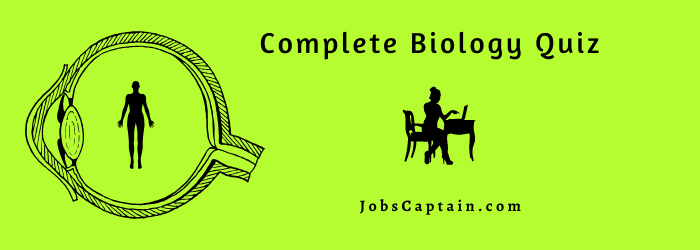
Test your science skill with Biology Quiz. Take a quick online test to improve your Science Biology knowledge with Biology MCQ with answers.
MCQ Quiz on Biology
Question 1. Digestion of carbohydrates begins where?
(A) stomach
(B) mouth
(C) colon
(D) small intestines
Question 2. Viral structure can best be described as:
(A) A clump of RNA surrounded by a protein coat
(B) A clump of DNA or RNA surrounded by a lipid coat.
(C) A clump of DNA surrounded by a protein coat.
(D) A clump of DNA or RNA surrounded by a protein coat.
Question 3. Which of the following is NOT found in bacteria?
(A) Plasma membrane
(B) Membrane bound nucleus
(C) Cell wall
(D) Ribosome
Question 4. When treated with Gram stain, Gram-positive bacteria appear:
(A) Purple
(B) Orange
(C) Pink
(D) Yellow
Question 5. How do viruses cause disease?
(A) Viruses insert their genetic material into host cells and use the host cell’s organelles to reproduce.
(B) Viruses within a host cell will burst out of the host cell and cause the host cell to die
(C) Both a and b are correct.
(D) Viruses release toxins that kill cells directly
Question 6. Which of the following statements concerning platelets is INCORRECT. Platelets:
(A) contain DNA
(B) are between 1/2 and 1/3 the diameter of the red cell
(C) are roughly disk-shaped
(D) have little ability to synthesize proteins
Question 7. Some scientists think life originated in:
(A) Desert plains
(B) Polar ice caps
(C) Deep sea hydrothermal vents
(D) Dry mountaintops
Question 8. Costal cartilage:
(A) cover the ends of the femur
(B) forms the intervertebral disks of the backbone
(C) attach the ribs to the sternum
(D) is found in the pinna of the ea
Question 9. Where are you likely to find a photoautotroph?
(A) In your digestive system
(B) In the darkness of the ocean
(C) In your refrigerator
(D) Near the surfaces of lakes, streams, and oceans
Question 10. How do bacteria cause disease?
(A) Bacteria release toxins that kill cells directly.
(B) Bacteria within a host cell will burst out of the host cell and cause the host cell to die.
(C) Bacteria insert their genetic material into host cells and use the host cell’s organelles to reproduce.
(D) Both b and c are correct
Question 11. Fertilization of the ovum by the sperm usually occurs in the:
(A) oviduct
(B) ovary
(C) vagina
(D) uterus
Question 12. Which of the following is NOT a function of the kidney?
(A) elimination of toxic substances
(B) excretion of urea
(C) regulation of fluids and electrolytes
(D) defecation
Question 13. Which is a function of the nucleus?
(A) The nucleus synthesizes protein
(B) The nucleus performs cellular respiration
(C) The nucleus is the command center of the cell
(D) The nucleus maintains turgor pressure
Question 14. Extinction of a species is most commonly caused by __________.
(A) deforestation
(B) habitat loss
(C) the introduction of an invasive species
(D) over pollution
Question 15. A layer of dead skin cells is found in the:
(A) dermis
(B) no dead cells are in the skin
(C) epidermis
(D) subcutaneous tissue
Question 16. Cariology is the study of the:
(A) kidneys
(B) tooth decay
(C) human heart
(D) liver
Question 17. Individual differences with a genetic basis lead to ______ in successive generations.
(A) variation
(B) normalization
(C) mutation
(D) extinction
Question 18. The human heart pumps blood to the lungs for oxygenation. This circuit of blood flow is called _______________.
(A) endocronic circulation
(B) pulmonic circulation
(C) lymphatic circulation
(D) systemic circulation
Question 19. The smallest of the FORMED elements of the blood are the:
(A) red cells
(B) platelets
(C) white cells
(D) erythrocytes
Question 20. A virus must do what to reproduce?
(A) conjugate
(B) form a latent virus
(C) infect a cell
(D) undergo transformation
Question 21. The blastula develops into the:
(A) gastrula
(B) zygote
(C) morula
(D) endoderm
Question 22. Which of the following tissues secrete hormones?
(A) gastro-intestinal tract
(B) pancreas
(C) ovaries
(D) all of the above
Question 23. A lytic cycle concludes with the:
(A) Production of messenger RNA
(B) Production of a bacteriophage
(C) Bursting of the host cell
(D) Embedding of viral DNA into the host cell’s DNA
Question 24. In cell division, the phase following the metaphas is known as:
(A) telophase
(B) anaphase
(C) extophase
(D) prophase
Question 25. The term “pathogen” refers to:
(A) A toxin produced by a virus that causes disease
(B) An organism or virus that causes disease
(C) A disease process
(D) A toxin produced by a bacterium that causes disease
